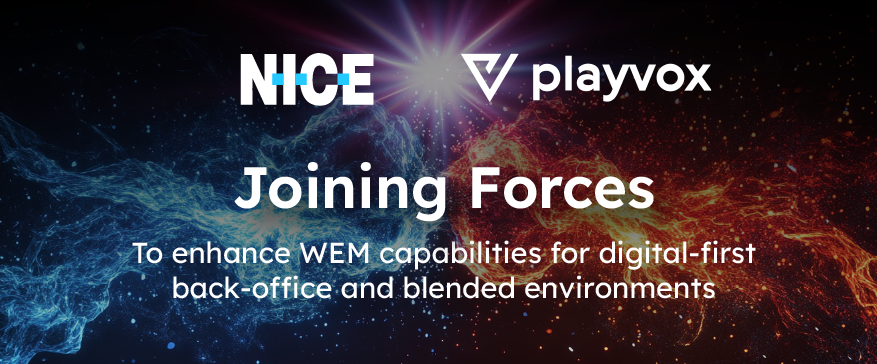How Customer Service Technology Is Shaping Agent Experiences
Customer service technology that delivers measurable, positive results starts with people—not technology.
According to Gartner research published in the Harvard Business Review, optimizing customer experience (CX) is not about shiny, over-the-top digital capabilities or automation alone. For customer service technology to truly move the needle, it must bridge technology and human-to-human connections—connections that begin and end with your customer support agents.
The Gartner research underscores the critical role employees play in customer satisfaction and long-term loyalty. In fact, their experiences matter just as much as your customers’ do. Customer service leaders at top-performing contact centers understand that. They know leveraging technology that directly improves both the customer experience and the agent experience is the key to success.
Can Technology Boost Human Connections?
Interactions between customers and customer service representatives—throughout customer journeys—are the most consequential drivers of contact center optimization. The right technology tools can improve human-to-human interactions and elevate every level of customer care. They also create work environments where agents are happy, challenged, and motivated to stay and grow with your contact center, which translates to operational efficiencies and significant cost savings.

In this post, we’ll explore seven ways people-focused customer service technology trends are reshaping agent experiences while boosting customer relationships and customer support center performance.
1. AI-Empowered Agents
There is no longer any question that the future of customer service will include Artificial Intelligence (AI). Next-generation tech solutions such as AI-powered chatbots, virtual assistants, and self-service portals accessible across digital channels empower agents through:
- Automation of repetitive tasks that quickly answer common questions and fulfill simple customer requests (order tracking, account inquiries, and basic troubleshooting, for example)
- Quick access to information across disparate, organization-wide knowledge bases, enabling better-informed decisions by agents
- Data insights for real-time personalized recommendations
With AI, customer service reps can refocus their efforts from basic questions to more complex issues requiring human intervention and intelligence. Agents’ value to customers increases as they are seen as trusted advisors, not merely problem solvers. The result is happier customers, more engaged employees, and increased productivity.
2. Predictive Analytics
In general, predictive analytics uses AI and machine learning algorithms to analyze historical data and identify patterns, trends, and correlations to predict outcomes. In the specific context of customer service, predictive analytics can anticipate customer issues, needs, preferences, and behaviors.
Predictive analytics includes past customer interactions, purchase history, and demographic data to identify common pain points and forecast potential issues before they arise and escalate. For instance, these insights can help contact center leaders know the number of agents required to handle contact spikes—across channels—during holiday peaks to develop better scheduling strategies.
The benefit of predictive analytics is improved connections, more positive conversations, and better customer service experiences, all of which add up to more satisfying daily experiences for agents.
3. Customer Sentiment Analysis
Sentiment analysis is an element of natural language processing that uses AI algorithms to examine text data and determine customers’ emotions in a given interaction. In the customer service industry, it can analyze customer feedback, social media mentions, and online reviews.
This kind of analysis of how people feel about what your brand is delivering is a powerful tool for CX measurement and optimization. When done well, it goes beyond traditional key performance indicators to provide a deeper and clearer understanding of your contact center agents’ strengths and opportunities for improvement.
Detailed insights from analysis of customer sentiment often reveal areas where small changes can have a big impact on CX—agent training, call scripts, or agent reward structures, for example. For agents, insights into customers’ emotions and attitudes enable them to tailor their interactions accordingly. For example, suppose a customer expresses frustration or dissatisfaction with a product or service. In that case, a sentiment analysis tool can alert the agent and immediately suggest empathetic responses to address their concerns effectively, avoiding escalation.
Creating context around words and following a more analytical approach to decoding customer sentiment also provides a more finely tuned understanding of customer satisfaction, consumer preferences, and overall public opinion. The meaningful insights from consumer sentiment analysis are essential to an agent- and customer-centric strategy.
4. Seamless Omnichannel Support
Customers now expect seamless omnichannel support from customer service centers—from email to video chat to social media channels. Sophisticated omnichannel support platforms integrate communication channels into a single interface, allowing agents to view and respond to inquiries across all channels, through one dashboard.
This streamlines workflows and enables agents to provide timely and cohesive support regardless of customer communication preferences. Agents can better manage their workload while reducing response times, creating a more satisfying experience for customers and less on-the-job stress for agents.
Customers also show an increasing interest in customer support self-service options within channels. According to Zendesk, 69% of customers say they’re willing to interact with a bot on basic issues. With technology that offers self-service options, customers can choose to quickly take care of problems on their own, easing ticket volume for your team.
5. Real-Time Collaboration
Some customer service technology now enables real-time collaboration and handoffs between agents and other functions within your contact center. For example, when chat specialists encounter complex technical issues requiring input from the product team or a higher level of technical support, this technology allows them to quickly escalate the conversation and collaborate to find solutions.
Real-time collaboration features such as internal messaging, shared notes, and tagging allow agents to communicate and collaborate effectively without leaving the customer interaction platform. This ensures that customer inquiries are resolved promptly and successfully, increasing both customer and agent satisfaction.
6. Personalized Training And Development
Customer service technology is also transforming agent training and career development. Interactive e-learning platforms and virtual reality simulations now offer personalized, engaging, and immersive learning experiences. They are replacing traditional training methods like large classroom sessions and manuals that quickly become outdated.

These e-learning platforms leverage AI algorithms to deliver customized teaching tailored to each agent’s individual learning style, team knowledge gaps, and organization-wide performance metrics. The platforms track agents’ progress in real-time, which allows supervisors to immediately identify areas for improvement and provide helpful, targeted coaching and feedback.
Many e-learning platforms also feature built-in assessments and progress-tracking tools that allow agents to monitor their own performance and measure their progress over time. This self-directed learning approach empowers agents to take ownership of their development and pursue continuous improvement at their own pace. And that’s good news for job satisfaction.
Microlearning also has emerged as a popular training technology in customer service, delivering bite-size learning modules focusing on specific topics or skills. By breaking down complex topics into smaller, more-digestible chunks, microlearning makes learning more accessible and manageable for agents. Incorporating gamification elements—like badges and leaderboards—motivates agents to complete their assigned training and track progress, giving them control over the process—and their own success.
7. Features For Flexible Work Arrangements
In an always-on digital culture, top contact centers are rising to meet consumer expectations for more than traditional nine-to-five support hours. Flexible and alternative work arrangements can be a double-sided benefit to CX by meeting expectations while improving the agent experience.

That flexibility can come in many forms, including work schedules, assignments, and locations. For agents, flexible work arrangements reduce stress, increase job satisfaction, and elevate productivity. For contact center operations, it often means more expansive services that better meet customer needs. It’s a major win-win.
Flexible work arrangements, enabled by remote desktop and cloud-based communication tools, allow agents to work from anywhere, providing greater autonomy over their schedules and more flexibility in their personal lives. It’s a boon for employee loyalty and big savings in recruitment and training costs.
Flexibility does come with a degree of complexity, though, as well as the challenges of change management. Communication, for example, can become more complicated. Research, though, indicates that this kind of flexibility boosts performance. A 2023 report by Upwork Research Institute found three common priorities among high-performing companies:
- The use of generative AI throughout the organization
- Flexible approaches to talent management
- Adoption of best practices for distributed teams
Workforce management software and applications can help with the challenges of flexible work arrangements. Many are designed to empower agents to handle their own scheduling, while some leverage AI to make capacity planning, forecasting, employee scheduling, and intraday planning easy, accurate, and far less time-consuming. Cloud-based technologies mean teams can easily access systems from anywhere, at any time.
Performance tracking tools and analytics dashboards also make it simple to identify top-performing agents and recognize their contributions publicly.
Resources To Help Shape Better Agent Experiences
Customer service technology is not only transforming interactions with customers and improving CX, it’s revolutionizing the daily lives of your customer service agents—for the better.
As organizations continue to invest in innovative customer service technology, the role of the customer service agent will evolve from problem solver to trusted advisor and brand ambassador. That shift is making human-to-human connections the linchpin in an optimized contact center.

Choosing the best tools to meet your CX center’s goals can feel daunting, but there are resources to help. Start with our on-demand webinar, Building The Agent Experience Innovation Center. Dan Smitley, LinkedIn Top Voice in Workforce Management, and Playvox Senior Vice President of Marketing Chrissy Calabrese discuss how WFM and improved agent experience positively impact customer experience and help create a cost-effective future for your organization.
You will learn:
- How agent experience improves customer experience
- How leaders play a critical role in enhancing agent experience
- The essential elements to build and innovate the agent experience in your contact center
Want to learn more about the Playvox tools that deliver better customer and agent experiences? Let’s talk.







